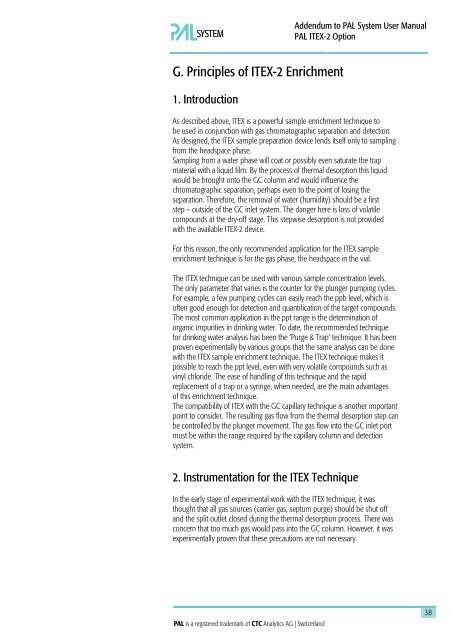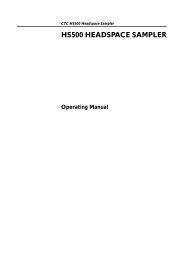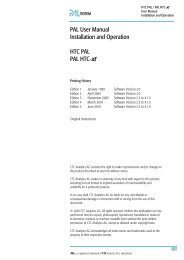Addendum to PAL User Manual Installation and ... - PAL System
Addendum to PAL User Manual Installation and ... - PAL System
Addendum to PAL User Manual Installation and ... - PAL System
You also want an ePaper? Increase the reach of your titles
YUMPU automatically turns print PDFs into web optimized ePapers that Google loves.
G. Principles of ITEX-2 Enrichment<br />
1. Introduction<br />
<strong>Addendum</strong> <strong>to</strong> <strong>PAL</strong> <strong>System</strong> <strong>User</strong> <strong>Manual</strong><br />
<strong>PAL</strong> ITEX-2 Option<br />
As described above, ITEX is a powerful sample enrichment technique <strong>to</strong><br />
be used in conjunction with gas chroma<strong>to</strong>graphic separation <strong>and</strong> detection.<br />
As designed, the ITEX sample preparation device lends itself only <strong>to</strong> sampling<br />
from the headspace phase.<br />
Sampling from a water phase will coat or possibly even saturate the trap<br />
material with a liquid film. By the process of thermal desorption this liquid<br />
would be brought on<strong>to</strong> the GC column <strong>and</strong> would influence the<br />
chroma<strong>to</strong>graphic separation, perhaps even <strong>to</strong> the point of losing the<br />
separation. Therefore, the removal of water (humidity) should be a first<br />
step – outside of the GC inlet system. The danger here is loss of volatile<br />
compounds at the dry-off stage. This stepwise desorption is not provided<br />
with the available ITEX-2 device.<br />
For this reason, the only recommended application for the ITEX sample<br />
enrichment technique is for the gas phase, the headspace in the vial.<br />
The ITEX technique can be used with various sample concentration levels.<br />
The only parameter that varies is the counter for the plunger pumping cycles.<br />
For example, a few pumping cycles can easily reach the ppb level, which is<br />
often good enough for detection <strong>and</strong> quantification of the target compounds.<br />
The most common application in the ppt range is the determination of<br />
organic impurities in drinking water. To date, the recommended technique<br />
for drinking water analysis has been the ‘Purge & Trap’ technique. It has been<br />
proven experimentally by various groups that the same analysis can be done<br />
with the ITEX sample enrichment technique. The ITEX technique makes it<br />
possible <strong>to</strong> reach the ppt level, even with very volatile compounds such as<br />
vinyl chloride. The ease of h<strong>and</strong>ling of this technique <strong>and</strong> the rapid<br />
replacement of a trap or a syringe, when needed, are the main advantages<br />
of this enrichment technique.<br />
The compatibility of ITEX with the GC capillary technique is another important<br />
point <strong>to</strong> consider. The resulting gas flow from the thermal desorption step can<br />
be controlled by the plunger movement. The gas flow in<strong>to</strong> the GC inlet port<br />
must be within the range required by the capillary column <strong>and</strong> detection<br />
system.<br />
2. Instrumentation for the ITEX Technique<br />
In the early stage of experimental work with the ITEX technique, it was<br />
thought that all gas sources (carrier gas, septum purge) should be shut off<br />
<strong>and</strong> the split outlet closed during the thermal desorption process. There was<br />
concern that <strong>to</strong>o much gas would pass in<strong>to</strong> the GC column. However, it was<br />
experimentally proven that these precautions are not necessary.<br />
38




